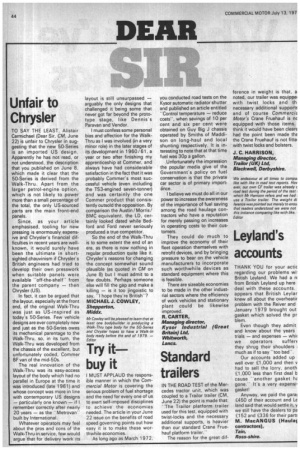Unfair to Chrysler
Page 46

If you've noticed an error in this article please click here to report it so we can fix it.
TO SAY THE LEAST, Alistair Carmichael (Dear Sir, CM, June 22) is unfair to Chrysler in suggesting that the new 50-Series is an imported US design. Apparently he has not read, or not understood, the description that you published on June 8, which made it clear that the 50-Series is derived from the Walk-Thru. Apart from the larger petrol-engine option, which is not likely to power more than a small percentage of the total, the only US-sourced parts are the main front-end panels.
Since, as your article emphasised, tooling for new pressing is enormously expensive and Chrysler's financial difficulties in recent years are wellknown, it would surely have been the ultimate in shortsighted chauvinism if Chrysler's British engineers had tried to develop their own presswork when suitable panels were available "off-the-shelf" from the parent company — then Chrysler (US).
In fact, it can be argued that the layout, especially at the front end, of the original Walk-Thru was just as US-inspired as today's 50-Series. Few vehicle designs are ever completely new and "just as the 50-Series owes its mechanical parentage to the Walk-Thru, so, in its turn, the Walk-Thru was developed from the chassis of the excellent, but unfortunately coded, Commer BF van of the mid-50s.
The real innovation of the Walk-Thru was its easy-access layout of the body which had no parallel in Europe at the time it was introduced (late 1961) and whose concept was more in line with contemporary US designs — particularly one known — if remember correctly after nearly 20 years — as the "Metrovan'" built by International.
Whatever operators may feel about the pros and cons of the Walk-Thru in service, few would argue that for delivery work its layout is still unsurpassed — arguably the only designs that challenged it being some that never got far beyond the prototype stage, like Dennis's Paravan and Vendor.
I must confess some personal bias and affection for the WalkThru as I was involved (in a very minor role) in the later stages of its development in 1960/61, a year or two after finishing my apprenticeship at Commer, and always have had considerable satisfaction in the fact that it was probably Commer's most successful vehicle (even including the TS3-engined seven-tonner) and was certainly the one Commer product that consistently outsold the opposition. By comparison the Austin/Morris/ BMC equivalent, the LD, certainly looked dated while Bedford and Ford never seriously produced a true competitor.
So the end of the Walk-Thru is to some extent the end of an era, as there is now nothing in regular production quite like it. Chrysler's reasons for changing the concept somewhat sound plausible (as quoted in CM on June 8) but I must admit to a few doubts. Perhaps someone else will fill the gap and make a killing — is it too jingoistic to say, "I hope they're British"? MICHAEL J. COWLEY,
Shepperton, Middx.
Mr Cowley will be pleased to learn that at least one bodybuilder is producing a WalkThru type body for the 50-Series and Chrysler hopes to have a Walk-In body ready before the end of 1979 — Editor








































































































































